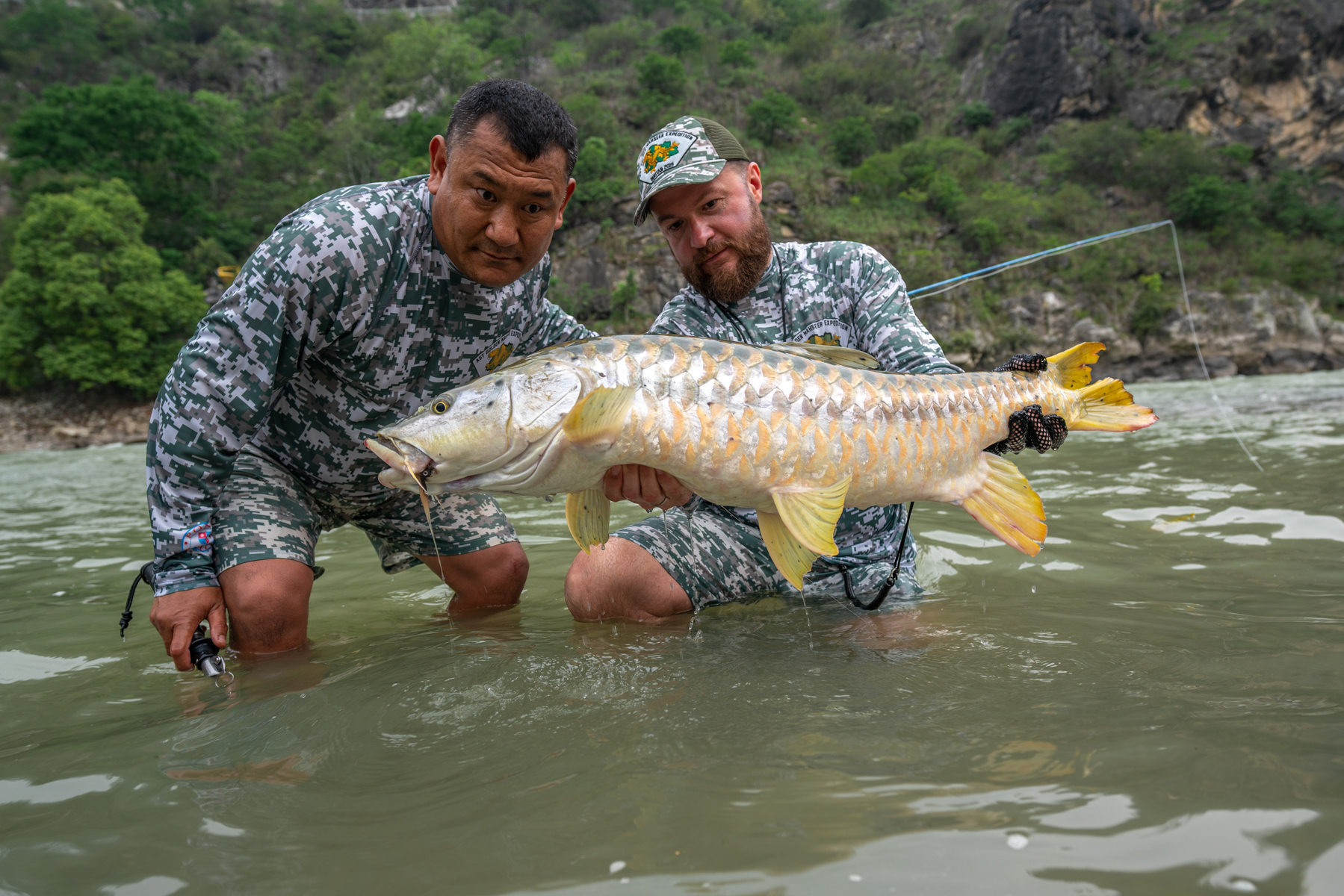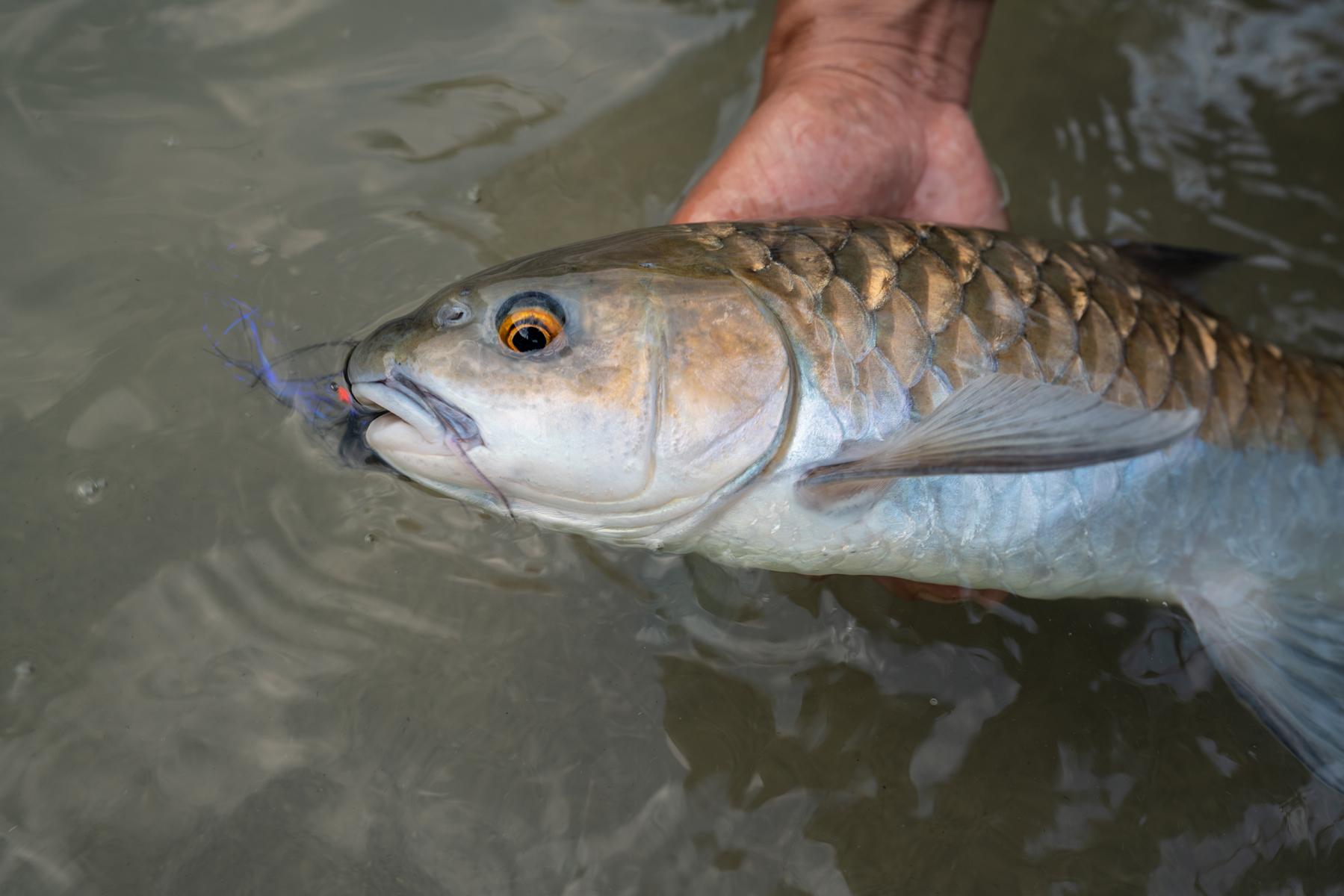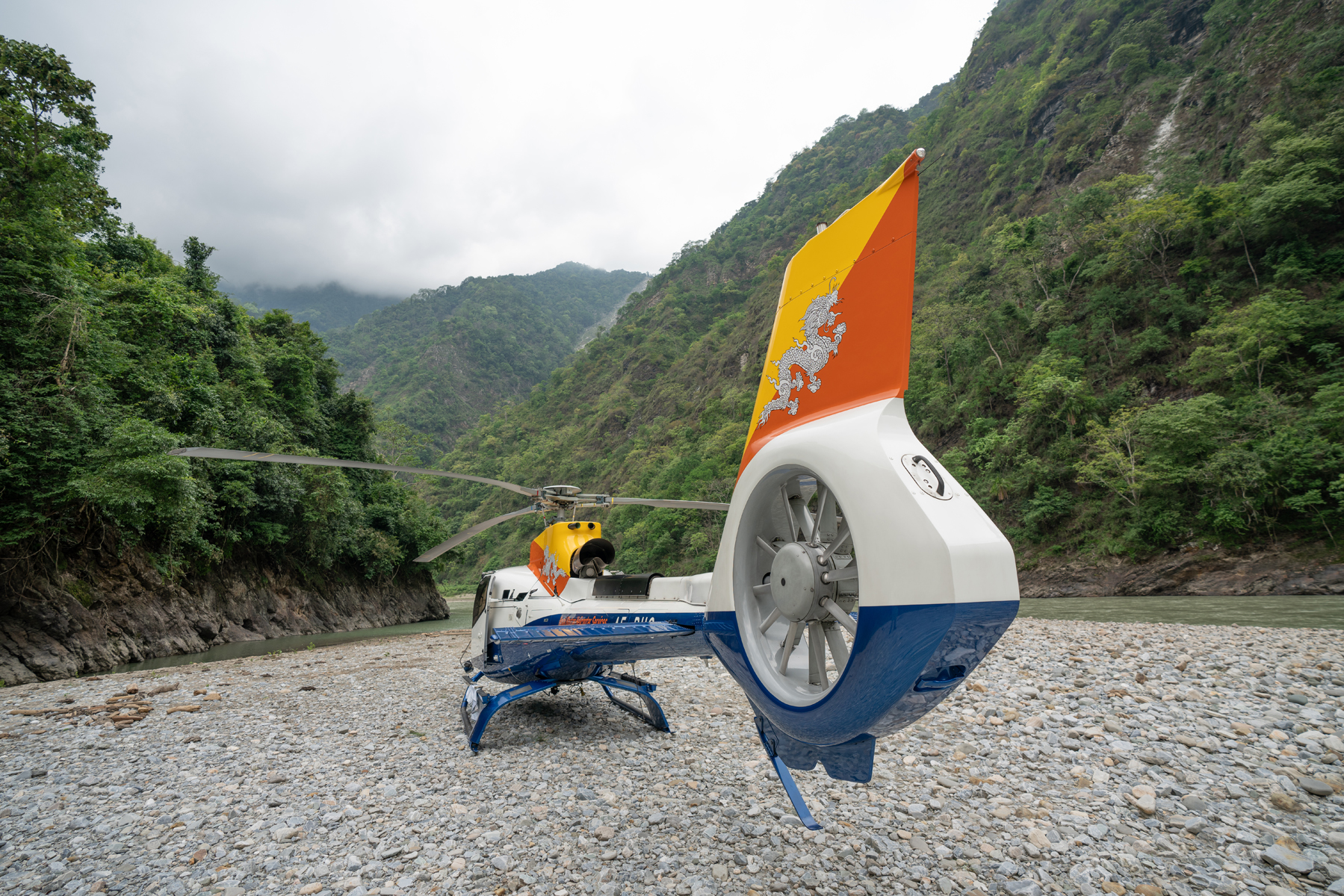
11 minute read
BHUTAN: Chasing Golden Mahseer in the Land of the Thunder Dragon
The morning sun cast a golden glow over Mount Everest’s snowcapped peak, marking the end of three days of continuous travel. As we descended toward Paro Airport, the realization set in — we had finally arrived in the mesmerizing Kingdom of Bhutan, also known as Druk Yul, meaning “Land of the Thunder Dragon
By KEITH ROSE-INNES

Ilya Sherbovich and I had been invited by our friends and avid fly fishermen, Ugyen Rinzin and Kencho Tshering. Years earlier, Ilya had fished alongside them for golden mahseer, and now he was returning—this time with me tagging along. Fishing for these prized fish in Bhutan requires special permission from the Royal Family’s office, as they are strictly protected. Ugyen had secured authorization for monitoring purposes, but only under a catch-and-release, fly-fishing-only basis.
The true significance of this trip would unfold as the days went by, but in the meantime, I was in awe of Bhutan—where prayer wheels spin in the wind, Buddhist flags drape the mountain ridges, and fierce dragon motifs adorn temple walls to ward off evil.

A Kingdom Steeped in Tradition
Nestled in the Eastern Himalayas along the ancient Silk Road, Bhutan is one of the few nations never to have been colonized. For centuries, Druk Yul remained secluded, preserving its deep-rooted Buddhist traditions and cultural identity. Its people, the Drukpa (Dragon People), are ruled by the Druk Gyalpo (Thunder Dragon Kings).
A testament to Bhutan’s unique approach to governance is the philosophy of Gross National Happiness, a concept introduced in 1972 by King Jigme Singye Wangchuck, who declared, “Gross National Happiness is more important than Gross Domestic Product.” This focus on well-being over wealth has shaped the nation’s development, ensuring the preservation of its heritage and values.


Into the Wild
Given Bhutan’s rugged terrain, a helicopter was essential for covering the vast distances required to fish the three planned rivers. After clearing customs, we boarded the chopper for a one-hour flight from Paro, descending from the crisp, cool air of the mountains into the humid, subtropical jungle. Our basecamp, set up along one of the main rivers, would be our launching point for the adventure ahead.


Despite our excitement, we knew very little about the river conditions, and local knowledge would be our key to success. The golden mahseer are notoriously elusive, known for their sharp senses and their reluctance to take a fly. Over the next ten days, Ugyen and Kencho would guide us on a journey that was as much about Bhutanese culture as it was about fishing. We would sip leaf cups of rice wine and bamboo mugs of potato beer, prepared by the locals, fully immersing ourselves in the country’s way of life.

The Challenge of the Golden Mahseer
Golden mahseer possess an extraordinary sense of smell and are incredibly sensitive to vibrations—traits that make them as frustrating to fish as permit. One advantage we had was their relatively poor eyesight, likely due to the mixture of murky and clear waters in the rivers. Still, their heightened senses meant that any misstep could spook an entire school.
On our first morning, we made our way to a clear creek above basecamp, where chocolate and golden mahseer were lined up in the current. As we approached, Ugyen cautioned, “Keep quiet, move slowly, and avoid touching the water—the fish will spook.”


My heart raced at the sight of so many large fish, and I naively assumed that landing one would be easy. Sensing my overconfidence, Ugyen laughed.
It was a humbling lesson in just how challenging this species could be
To demonstrate the mahseer’s sensitivity, Kencho asked one of our expedition members standing 20 meters upstream to submerge his hands in the water. As the scent drifted downstream and reached the main river, every single fish vanished in an instant, not returning until the following morning. It was a humbling lesson in just how challenging this species could be.


Stealth and Strategy
Understanding that even the slightest disturbance could ruin our chances, we adapted our approach. The helicopter would avoid flying over clear creeks and would land far downstream to prevent vibrations in the water. Once on the riverbank, we meticulously planned our casts— washing our hands, wetting our lines and flies, and walking carefully to the casting area. Every move was calculated, every cast deliberate.
Often, the problem wasn’t a lack of fish but rather an abundance of them. With so many in close proximity, spooking one would set off a chain reaction, leaving us with no takes at all. Through trial and error, we refined our techniques, experimenting with different fly patterns and presentations. Just as we started gaining confidence, the unpredictability of nature threw another challenge our way— rain. Changing conditions caused the rivers to fluctuate daily, with tributaries either clearing or becoming unfishable due to flooding from the distant Himalayas.


The Ones That Got Away
One particular pool became an obsession. Every visit, we spotted fish exceeding 60lbs—massive, intelligent, and seemingly untouchable. Despite careful planning and numerous fly changes, they remained uninterested.
On our first attempt, Ilya hooked a monster on his very first cast, but it tore downriver through the rapids, snapping his fly line and part of his braided backing in the process. Subsequent visits yielded more sightings but no bites.
I had my own brief encounter with a giant mahseer at a river junction. The moment I set the hook, the fish exploded downstream. I sprinted, stumbled, and swam in pursuit, but within seconds, my reel was spooled, and the fish was gone. That evening, I consoled myself in a traditional Bhutanese stone bath, sipping cans of Bhutan Glory beer—the only thing I had successfully “landed” that day.


The Last Cast
As our trip neared its end, we had yet to land a true monster. On the final morning, we took it as a good omen when we spotted a longtailed monkey drinking from the opposite bank—considered a sign of luck. That luck materialized when Ilya hooked into a behemoth mahseer.
A familiar feeling of déjà vu struck as the fish surged across the river toward another set of rapids. We scrambled along the boulder-lined shore, chasing it as far as possible. Just as we thought we were about to lose it, the fish unexpectedly turned and swam straight toward us, settling into a back eddy. In disbelief, I dropped my camera, grabbed the net, and made a desperate lunge. The fish barely fit—it was massive.We carefully weighed it using two different scales, confirming a staggering 55lbs, allowing for the sling. It was the perfect finale to an unforgettable expedition. Over eight incredible days, we had landed 35 golden mahseer, including ten fish over 20lbs and two giants weighing 36lbs and 55lbs.



Bhutan had given us an adventure of mammoth proportions - one defined by breathtaking landscapes, humbling encounters, and the unparalleled thrill of chasing golden mahseer in the Land of the Thunder Dragon.
NB! Since the article was written, Bhutan has started to allow fly fishing for Mahseer. However, at the time of writing it was illegal – and only possible with special permission granted by the king.

Land of the Thunder Dragon // Geography
Bhutan, a small, landlocked country in the Eastern Himalayas, is bordered by China to the north and India to the south, east, and west. Its diverse topography ranges from snow-covered peaks exceeding 7,000 meters (22,966 feet) in the north to subtropical plains in the south. The country is dominated by rugged, forested mountains and deep river valleys, which play a crucial role in shaping its climate and culture.
The northern region features glaciated peaks and alpine meadows, home to rare wildlife like the snow leopard and blue sheep. The central region consists of temperate valleys and dense forests, supporting Bhutan’s traditional agriculture and ancient monasteries. The southern lowlands, part of the Indian subcontinent’s foothills, are covered in lush subtropical jungles, where elephants, tigers, and golden langurs roam.



Bhutan’s major rivers, including the Drangme Chhu, Puna Tsang Chhu, and Wang Chhu, originate from the Himalayas and flow southward, carving dramatic gorges before joining India’s Brahmaputra River. These waterways are vital for hydroelectric power, Bhutan’s largest export.

Population and Culture
Bhutan has a population of approximately 800,000 people, making it one of the least densely populated countries in the world. The majority belong to the Drukpa ethnic group, with smaller communities of Nepali-speaking Lhotshampa and indigenous tribes in the south. Bhutanese society is deeply rooted in Mahayana Buddhism, which influences everything from governance to daily life. Prayer flags flutter across mountain passes, and dzongs (fortress-monasteries) serve both as religious centers and government offices.

The capital, Thimphu, is Bhutan’s largest city and the political and cultural hub. However, unlike most capitals, it has no traffic lights— local authorities believe that traffic flows better under the guidance of uniformed officers. Other major towns include Paro, home to Bhutan’s only international airport, and Punakha, the former capital, known for its stunning riverside dzong.

Bhutanese people follow a philosophy of Gross National Happiness (GNH), prioritizing well-being, cultural preservation, and environmental sustainability over economic growth. The country maintains a strong commitment to conservation, with over 70% of its land covered in forests and a constitutional mandate to keep it that way.

How to Get to Bhutan from Europe
Bhutan’s remote location and strict tourism policies make it a unique destination that requires careful planning. The only international airport, Paro Airport (PBH), is served by just a few airlines, primarily Drukair and Bhutan Airlines.
Since there are no direct flights from Europe, travelers typically transit through one of the following Asian hubs: New Delhi, India (DEL) – Frequent Drukair flights connect Delhi to Parom, Bangkok, Thailand (BKK) – One of the most popular transit points, with daily flights to Paro, Kathmandu, Nepal (KTM) – A short but scenic flight over the Himalayas to Paro, Singapore (SIN) – A longer route but an option for Southeast Asia-based travelers, or Kolkata, India (CCU) – A convenient gateway with frequent flights.Most visitors must arrange their trip through an authorized Bhutanese tour operator, as independent travel is not allowed. A daily tourist tariff applies, which covers accommodation, meals, transportation, and a licensed guide. This policy helps control visitor numbers and ensure sustainable tourism.


Once in Bhutan, travel within the country is typically by road, as domestic flights and helicopter services are limited. The mountainous terrain means that even short distances can take several hours by car. However, the journey is always breathtaking, with winding roads revealing stunning valleys, ancient monasteries, and pristine rivers.
Bhutan’s seclusion and commitment to preserving its culture make it one of the world’s most fascinating travel destinations - where ancient traditions, untouched nature, and spiritual depth converge in the heart of the Himalayas.











